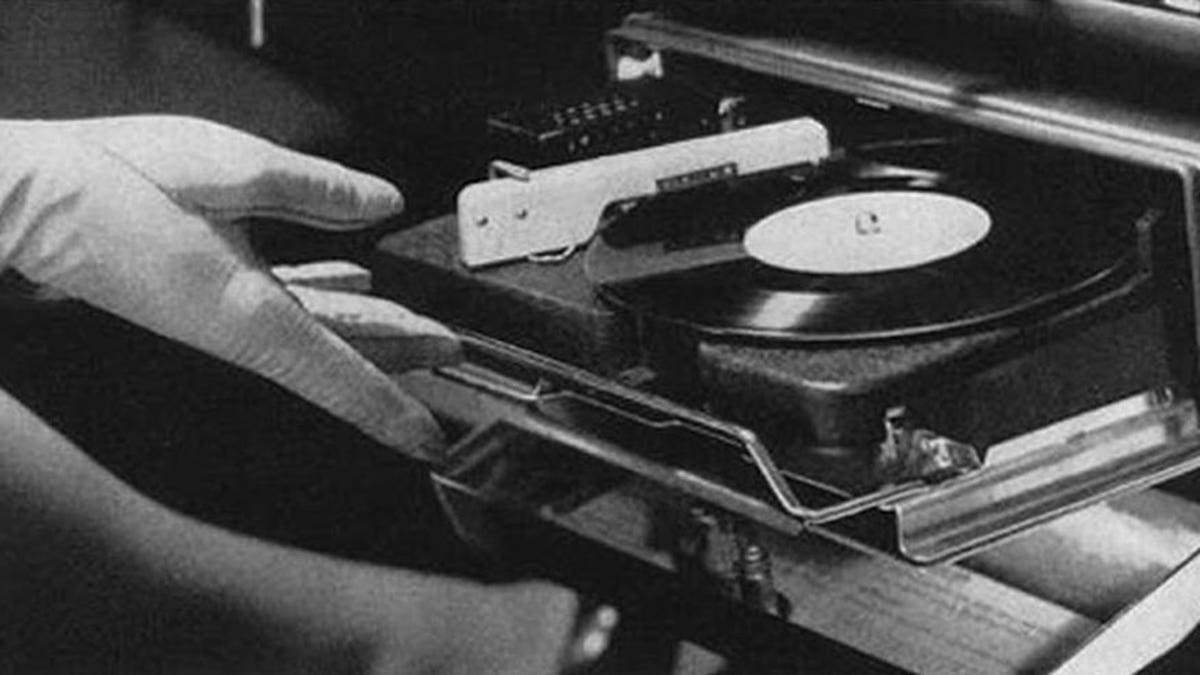
(Chrysler)
Today's car infotainment systems offer drivers and passengers an array of state-of-the-art features that can dazzle even the most savvy techno-geek. (Unfortunately, these same high-tech systems can be complicated to use and prone to technical problems, as we detailed in "High-Tech Automotive Headaches.") On the audio front, the listening options are vast, including AM/FM, satellite, and Internet radio, CDs and DVDs, and audio files you play via plugged-in or Bluetooth-enabled smart phones, music players, and off a built-in hard drive. Cars have long had music players beyond radio. Anyone of a certain age will remember 8-track and cassette players. And record players. Record players? Yep.
A new technology came on the market in the mid-1950s and early 1960s that freed drivers from commercials and unreliable broadcast signals (and even rock 'n' roll, if they chose), allowing them to be the masters of their motoring soundtrack with their favorite pressed vinyl spinning on a record player mounted under the dash. Consumer Reports covered three auto record player units of the day.
The “Highway Hi-Fi” was the first on the scene, available from the Chrysler Corporation as an option on the 1956 Chrysler, Desoto, Dodge, and Plymouth. CBS Labs developed the technology that played records specifically designed for the system, with 7-inch discs in 16⅔rpm format, available exclusively from Columbia Records. The format was chosen because 33⅓ rpm records at 12 inches in diameter were too big for the car and the smaller 45 rpm size didn't play as long. The 7-inch size developed for the "Highway Hi-Fi" fit in the car and played for about an hour per side.
Chrysler started the auto audiophile's collection with six records from Columbia that presented mellifluous motoring tracks such as “I'll Take Romance” from Percy Faith and His Orchestra. Additional recordings were available for order. The Great American Songbook was represented with picks such as Cole Porter's score for the Broadway show “Kiss Me, Kate” and "My Old Kentucky Home" played on a Wurlitzer organ. And there were talk selections, too, including recordings of the CBS radio series “You Are There” featuring historical topics such as “The Signing of the Magna Carta” and “The Battle of Gettysburg.” (You can listen to CBS' classic “You Are There” series on the Internet Archive.)
The Highway Hi-Fi was short-lived as Chrysler only offered it for two years. Consumer Reports did not test it, but we did report its demise, suggesting that the price tag of nearly $200 (over $1,700 today) and the constraint of buying proprietary records from Columbia were probably reasons for the player's short run. Chrysler did eventually add an option to play 45 rpm records on the Highway Hi-Fi, but perhaps that choice came too late.
In 1960, a much cheaper car record player offered as a Chrysler option came on the market: the RCA Victor auto "Victrola." It cost $51.75 ($410.47 today) and you could play your own 45s on it. We bought one and tested it in the lab and on the road.
The RCA “Victrola” held 14 records and could play for 2½ hours continuously, if extended play 45s were used. Our test drivers found the record changer "easy to operate while keeping eyes on the road ahead." Music without distracted driving. Imagine that.
More From Consumer Reports
By contrast, the similarly-priced Norelco “Auto Mignon,” which we tested a year later, only held one 45 rpm record at a time, for 4½ minutes of play at best, potentially distracting the driver with the need for multiple record changes. And there was the question of where to put the vinyl since the Norelco didn't store any records, as the RCA model did, leaving a box on the floor or car seat as the alternative.
Surprisingly, we found in our tests of the RCA and Norelco players that both units were able to keep the needle on the record while driving. Of the RCA, we wrote: "The stylus did not jump the grooves even when the car was moving at various speeds over broken pavement, cobblestones, and deep holes." We gave the Norelco a similar assessment, describing the needle performance as being “unaffected by rough roads, car sway, and sharp braking.” But a steady stylus had its price, wearing down the records from the high pressure required to keep it in place. And the RCA unit's turntable ran fast, speeding up records. We described this defect as “bound to be strongly annoying with many types of music.” And speed metal hadn’t yet been invented.
Despite the possibility that it could turn a ballad into “Flight of the Bumblebee,” we concluded that the RCA Victor auto “Victrola” was, overall, more satisfactory than the Norelco “Auto Mignon,” “as a means of bringing self-selected music to the lonely motorist.”
But the RCA Victor was only available in 1961, with the company discontinuing the "Victrola" after that model year.
Car record players soon made way for the next new-fangled audio gizmo: the eight-track tape deck. The Chrysler Corporation introduced it as an option in its 1968 cars.
Fast forward to 2014, and now multifaceted, phone-integrated infotainment systems are the rage. And radio still has reception issues and too many commercials.
Read “5 Things to Look for in a Car Infotainment System."
—Sharon Riley
Copyright © 2005-2014 Consumers Union of U.S., Inc. No reproduction, in whole or in part, without written permission. Consumer Reports has no relationship with any advertisers on this site.